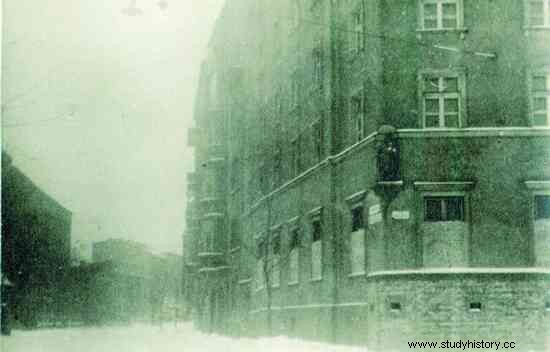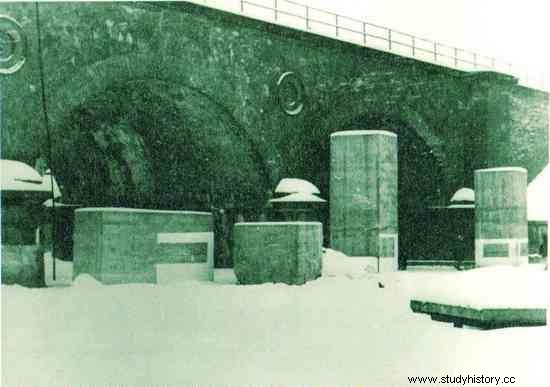Krakow for over five years served as the "capital" of the General Government. Therefore, as the front grew closer and closer to the city, it was decided that it would become a fortress. It was intended to defend Festung Krakau for many weeks, which was to bind considerable forces of the Red Army. It was also supposed to ruin the former capital of Poland ...
The Krakow defense plan was based on two elements. The first was a strip of earth fortifications built from August 1944, several dozen kilometers east of the city. Many Cracovians worked on their construction and the protective shaft itself - it was called by the Germans - it consisted of 3-4 tightly connected defense lines, which were to stop the attacking units of the Red Army. However, when it came down to it, the Germans did not have the strength to fill him, and he did not do much.
Festung Krakau
However, what would Krakow be like if the city itself had not been properly prepared! As Grzegorz Jeżowski writes in one of the chapters of the book "Krakow - Nazi Occupation 1939-1945":
The occupation authorities built fortifications that made it possible to conduct circular defense of the entire city. […] The outer defense of the city was not a continuous fortification, it was a set of interconnected resistance points and trenches.

The house on Lea Street and Plac Inwalidów is prepared for defense. The windows on the ground floor were often built-in, and brick barriers with shooting positions were erected in front of the entrance gate and in other strategic places. The photo and description come from the book "Kraków - time of occupation 1939-1945" (MHK, 2010).
Expecting an attack from the east, an anti-tank ditch was dug from the village of Mogiła to the village of Grębałów, four meters wide and three meters deep.
The next line of defense was already based on dense urban development, and its axis was the circumferential railway line running from Łobzów to Prokocim on the other bank of the Vistula. The last bastion was to be the city itself, which - according to what Professor Andrzej Chwalba writes in the book "Okupacyjny Kraków in 1939-1945" - remained:
divided into zones and sections. [Germany] They strongly fortified government buildings, barracks and blocks of flats in the German quarter. They bricked up the windows on the ground floor or left arrowslits in them, secured with a wire mesh. In many parts of the city, they built reinforced concrete, brick or earth bunkers with loopholes. They built only 50 reinforced concrete ones.
Along the roads, shooting ditches were dug and anti-aircraft guns were set up. Many of Kraków's numerous cellars have been linked into a complex network of underground passages that provide both shelter and an unexpected counterattack.
The Germans also erected more than 240 dams and anti-tank poles on exit streets and intersections in the city. In key strategic points of Krakow - mainly in the eastern part of the city - the occupant also erected quite mysterious concrete poles with a diameter of two and a height of four meters. As it quickly turned out, thanks to the powerful explosives placed at their base, they were to be blown up at the right moment, creating additional anti-tank barriers.

German anti-tank poles next to the railway viaduct over Grzegórzecka Street. The photo and description come from the book "Kraków - time of occupation 1939-1945" (MHMK, 2010).
A number of bunkers were built to protect against air attacks, and two large fire tanks located in the Main Market Square were to help extinguish the expected fires. The expansion of the airport in Rakowice and the construction of emergency airports in Błonia and Bronowice were also not neglected.
In addition, some buildings were mined (including the power plant, gas plant, waterworks and the Mining Academy), as well as crossings over the Vistula River. All this was to - according to the assurances of German propaganda - translate into weeks-long defense that would tie a large number of Soviet units.
Krakow would be a pile of rubble

Festung Krakau. German plans for the defense of Krakow ”is another article that we publish as part of our cooperation with the Historical Museum of the City of Krakow. It was created, inter alia, on the basis of the album "Krakow - occupation time 1939-1945"
Despite such advanced works, the situation looked gloomy for the Germans from the very beginning, which the commander of the defense of Festung Krakau Generalmajor , appointed in October 1944, was well aware of. Hermann Kruse. General was of a similar opinion Friedrich Schulz, head of the 17th Army, and Governor General Hans Frank himself. The main problem of the defenders was the lack of a sufficient number of soldiers. Most of the units were sent to Hungary as early as in the fall of 1944.
Kruse's fears were absolutely right, and the situation became even more complicated when the great offensive of the Red Army began on January 12, 1945. It turned out that the Soviets did not intend to attack the city frontally, but made a deep encirclement, forcing the German command to surrender Krakow practically without a fight.
It is true that the city of Krak suffered to some extent when the bridges were blown up by the retreating Germans, as well as bombing and artillery fire by the Red Army, but it was a small price, considering the possible scale of damage with a defense of several weeks.
If Festung Krakau were actually used, the city would not have left a stone on a stone , and today, on the Wawel Hill, we would see at most a faithful reconstruction of the former castle ...
We recommend:
Permanent exhibition "Krakow - during the occupation 1939-1945" in the branch "Oskar Schindler's Enamel Factory" Historical Museum of the City of Krakow (4 Lipowa Street, office open seven days a week. Free admission on Monday).
